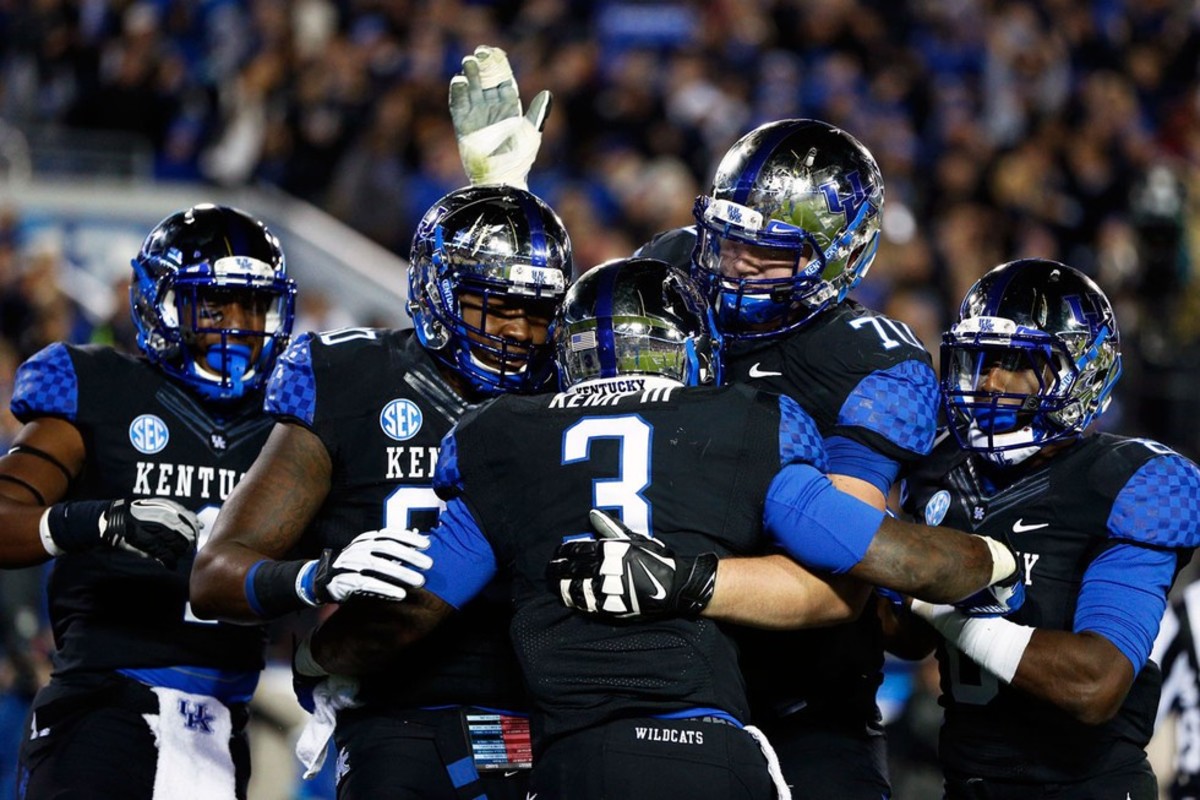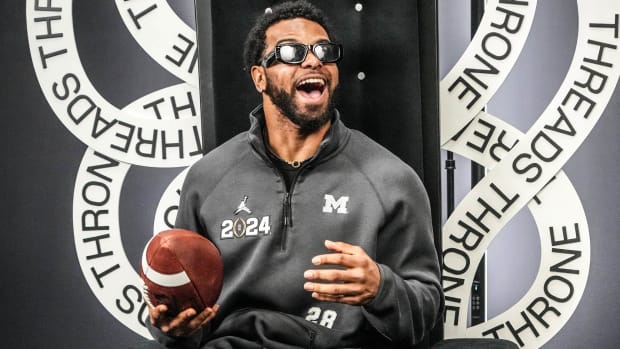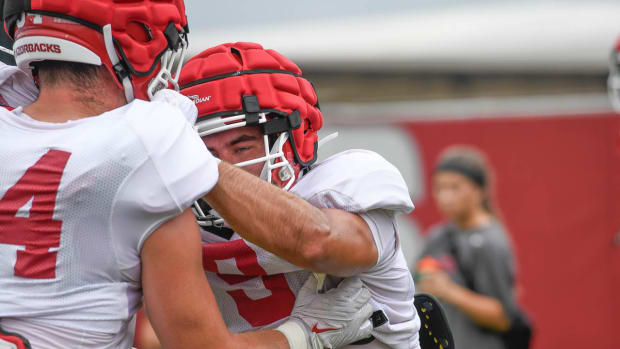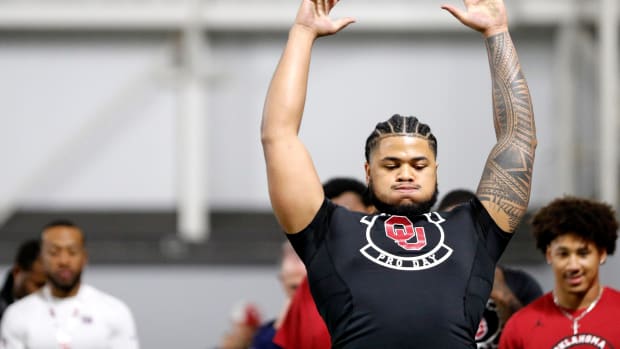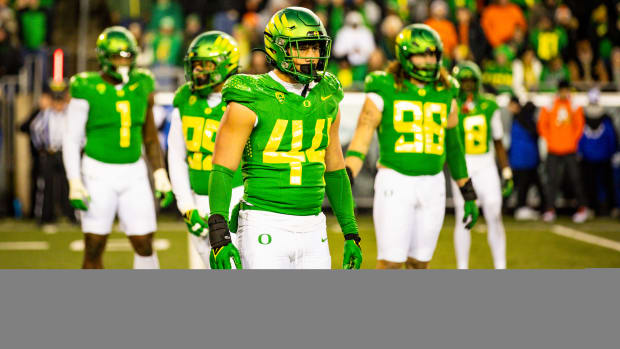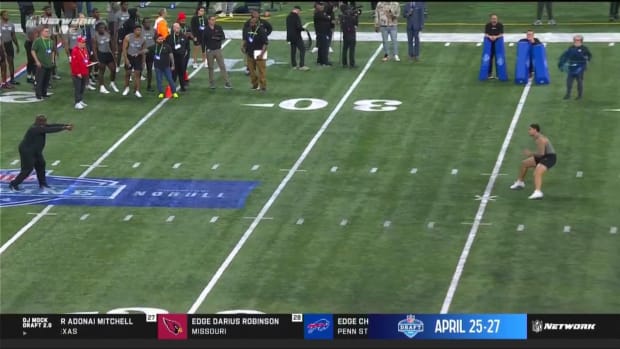The Wildcat Catalysts: A look at the men responsible for Kentucky's recent football renaissance
LEXINGTON, Ky.—Kentucky's team room in the E.J. Nutter Training Facility looks much the same as it did when coach Mark Stoops arrived in Lexington three years ago. The primary differences are a pair of blue signs hanging on the main wall at the front of the oversized auditorium. One lists the program's core values: character, attitude, accountability, dependability, all-in. Just to the right, a similar poster touts the Wildcats' guiding principles, including no shortcuts and do the right thing.
Stoops, Kentucky's third-year head coach, had both signs put up after he took the Wildcats job in December 2012. The longtime assistant coach had inherited a program that had won just four SEC games in the previous three seasons. Before Stoops could help Kentucky win, he had to convince the Wildcats that winning was possible. Cultivating an attitude of belief was crucial in the locker room, an important aspect of his overhaul of the program's culture.
Today players insist that this isn't your father's Kentucky football team. "You can feel it," senior linebacker Josh Forrest says. "You can feel the difference." The program went from 2–10 in Stoops's first season to 5–7 in 2014. This fall the Cats are 4–1 with wins over South Carolina and defending SEC East champion Missouri. On Thursday they'll host Auburn at a sold-out Commonwealth Stadium in Kentucky's first Thursday home game since 1939.
Stoops is the most prominent figure in the program's rebuild, but each cog in the Wildcats' machine believes the team is close to shaking up the SEC establishment. That begins with five men, better identified by their roles: the coach, the athletic director, the quarterback, the recruit and the draft pick. "For the first time in the 14 years I've been here, we've got all the pieces lined up," says Kentucky AD Mitch Barnhart.
*****
Lexington Herald-Leader/Tribune News Service/Getty Images
Just down the road from the football complex, construction continues on the Wildcats' new $45 million practice facility. The building's 98,000 square feet will connect to Nutter Field House, on the eastern end of Commonwealth Stadium, which itself underwent a $120 million facelift earlier this year. From his corner office, Stoops can watch a new era of Kentucky football rise from the ground up.
"To see the things that have happened here in three years, when you look at it on that scale, none of it was done when I walked in the door," Stoops says. "It's ridiculously fast. If I didn't feel I was going to have that, I'm not sure I'd be here."
Stoops spent 22 seasons as an assistant coach before coming to Lexington. Growing up in Youngstown, Ohio, he played football under renowned coach Don Bucci at Cardinal Mooney High. Stoops's late father, Ron, was Bucci's longtime defensive coordinator, so bus rides and sweltering practices defined childhood for Mark and his three older brothers—Ron Jr., Bob and Mike—all of whom also went on to become college football coaches. Mark played defensive back at Iowa from 1986 to '88 for Hayden Fry, who offered Stoops his first coaching gig as a grad assistant. "I remember always being on the edge of my seat listening to Hayden talk," he says.
Twenty years later Stoops coached in two national championship games as the defensive backs coach at Miami, winning the title in 2001. In '04 he got his first chance to be a defensive coordinator from his brother Mike, the coach at Arizona. Mark worked in Tucson for five years before leaving for Tallahassee, where he began a successful run leading Florida State's defense from 2010 to '12.
Stoops then left the Seminoles to take on the job in Lexington. The challenge was obvious: The Wildcats were a basketball powerhouse, but hadn't won an SEC title in football since 1976. Since the league split into divisions in '92, Kentucky had never won more than four conference games in a season or finished higher than third in the East. Stoops, who had no experience as a college head coach, admits that his brothers were supportive of him leaving Florida State, but also "a little cautious." (The talented Seminoles would go on to win the BCS national championship a year later.)
In the back of his mind, though, was how good it had felt to rebuild the program at Arizona. On Dec. 5, 2009 the Wildcats upset No. 18 USC 21–17 at the Coliseum in Stoops's final game before he left for Tallahassee. He wanted to experience that same feeling at Kentucky. "I'd been through it with my brother Mike," Mark says. "I saw the advantages and disadvantages of taking over a program."
When Stoops arrived, Kentucky's locker room lacked the consistency and attitude necessary to be great. The Cats had resigned themselves to being doormats in the SEC. Stoops strived to change that, and he started with the head coach. "When he talks, when he gets hype, you can just see that passion," says senior defensive end Farrington Huguenin. "That's the type of guy you want to play for." Says quarterback Patrick Towles, "That's a mentality this place hasn't seen in a long time."
But Stoops also knew that at some point Kentucky would have to deliver on the field. Thus far this season that is exactly what the Wildcats are doing. For the second year in a row, they have jumped out to a 2–1 start in the SEC. No Kentucky team had done that since the 1949 and '50 seasons, when a coach named Paul (Bear) Bryant was wandering the Wildcats' sideline. Heading into Thursday's matchup with the Tigers, Kentucky is only two wins away from becoming bowl-eligible for the first time since 2010. "I really feel like we're just getting started," Stoops says.
*****
David Stephenson/AP
The enthusiasm took Mitch Barnhart by surprise. When the Wildcats athletic director met with Stoops in 2012 to discuss Kentucky's coaching vacancy, Barnhart expected that he would need a strong sales pitch. Consider the situation: Stoops was in his third year as an integral part of Florida State's rejuvenation in the ACC. The Cats, meanwhile, weren't relevant in the SEC standings.
But Barnhart soon realized he didn't need a hard sell. Instead, Stoops sold himself. "Mark was on the edge of his seat, chomping at the bit," Barnhart says. "It wasn't a matter of me saying, 'We need you to be here.' He was saying, 'I'm ready to come.'"
Stoops fit Barnhart's preferred profile for Kentucky's next coach. First, Stoops knew defense. In 2012 the Wildcats ranked 13th in the SEC in scoring defense, allowing 31.0 points per game. Barnhart also wanted his next coach to expand the team's recruiting efforts. Ohio was a big part of that plan, and few football families were better connected in the state than Stoops's.
So, it surprised Barnhart when Stoops laid out a blueprint that was nearly identical to his. "It was clear he [had] thought about it," Barnhart says. "He said, 'It's a place I think you can win, and here's why.' And he outlined all the things we talked about."
Barnhart knew what successful football looked like at Kentucky. Not long after he arrived in Lexington in July 2002, Barnhart hired Rich Brooks as the Wildcats' coach. Brooks took over just as Kentucky was being hit with NCAA sanctions incurred by the previous coaching staff. He nevertheless won at least seven games on four occasions. He also won three bowl games. In October '07, Brooks led Kentucky to a No. 8 ranking in the AP Poll after wins over top-ranked LSU and eighth-ranked Louisville.
Brooks retired after seven seasons in Lexington, but his handpicked successor, longtime assistant Joker Phillips, was unable to replicate his success. In November 2012, a day after the Wildcats suffered an embarrassing 40–0 home loss to Vanderbilt to fall to 1–9, Barnhart fired Phillips. "You know that [coaching changes happen] to other programs," says Towles, who was a freshman at the time, "but you don't think it's going to happen to yours."
At the time of Phillips's dismissal, the SEC was nearing the end of a seven-year streak of BCS titles, with four different teams from the conference having won championships in that span. Kentucky needed to hire a coach who made it clear that the Wildcats were committed to surviving in the nation's toughest league.
Fans have responded to Stoops's positive message. Three of Kentucky's first four 2015 home games have been sellouts, and no tickets are available for Thursday's game against Auburn. Barnhart says that Stoops also played a crucial role in helping push through renovations to Commonwealth Stadium and construction of the team's new practice facility.
"I don't care whether you're 75, 55, or 25, Mark can cross all those lines with everyone," Barnhart says. "He has an ability to communicate and genuinely engage with people at all levels."
*****
Lexington Herald-Leader/Tribune News Service/Getty Images
When Patrick Towles arrived in Lexington in 2012, he didn't know how to lose. The quarterback at Highlands High in Fort Thomas, Ky., had finished his high school career the year before with more state titles (three) than defeats (one). In addition to being a state powerhouse, the Bluebirds were also serious about weight training and off-season conditioning. "It was cool to try hard," Towles says.
But the quarterback caught a different vibe from the Wildcats. During a workout his freshman year, the 6' 5" Towles smoked his new teammates in a sprinting drill. "I'm thinking, Okay, a slow white guy?" Towles says. "I should not be winning all of the gassers." Then a senior put his arm around the quarterback. "Hey man," he said, "you'll learn." Such complacency astounded Towles. Had he signed with a program that didn't care about winning?
Today Towles is a redshirt junior and a primary catalyst behind Kentucky's 4–1 start. He has watched as the program has changed its culture from the inside out. Now it is no longer content with being an SEC doormat. "It's that loser's mentality that we can't have," Towles says. "And we don't have that anymore."
Towles long dreamt of playing quarterback for the Wildcats. He grew up 90 minutes from Lexington with Big Blue blood in his veins; his parents, Terry and Amy, met as classmates at Kentucky, and his older sister, Bekah, also graduated from the school. Towles's childhood included trips to Rupp Arena and tailgates in the shadow of Commonwealth Stadium. For years he wanted nothing more than to make the Wildcats relevant in the SEC.
Towles's freshman season in 2012 was a gut-punch to those hopes. Kentucky went 2–10 and Barnhart fired Phillips, who had recruited the quarterback. Towles wondered if Lexington was truly the place for him.
But Towles shifted his focus when the Cats hired Stoops. Towles learned of the news while peeking at Twitter during a biology class. The Stoops name alone piqued his interest. "Okay," he thought, "Kentucky must be serious about football now."
After redshirting in 2013, Towles won the starting job last season and led the Wildcats to a 5–7 record. He became the first Kentucky quarterback in five years to gain at least 3,000 yards of total offense. The Wildcats went down to the wire in tight losses to Mississippi State and Florida. They also rallied from 14 points down to sink South Carolina, 45–38, the biggest fourth-quarter comeback in program history. "That really kind of told us, Hey, we can play with these guys," Towles says.
Towles and his teammates knew that they still weren't where they wanted to be; a crushing 44–41 season-ending loss to rival Louisville had cost Kentucky bowl eligibility. But the Wildcats' growth in 2014 showed they were headed in the right direction. In August Towles hopped on The Paul Finebaum Show and said that Kentucky had the talent reach the SEC title game. Immediately the quarterback heard from critics on Twitter. "I could definitely tell people weren't used to hearing that," Towles says.
The Wildcats' 21–13 victory over No. 22 Missouri on Sept. 26 was Kentucky's first win against a ranked opponent in the Stoops era. Towles, a staunch Catholic, had fielded texts from his Wildcats teammates the week of the game, which coincided with the pope's recent visit to the U.S. The gist of all the messages was, according to Towles, "Your boy's in town. You'd better play well." The quarterback responded by completing 22 of 27 attempts for two touchdowns against the reigning SEC East champs.
Towles has witnessed both sides of Kentucky football: the hopeless and the hopeful. He says that the talent level on the Cats' roster is far better than it was when he arrived as a freshman. Tents popped up last month near Rupp Arena in advance of Midnight Madness, the unofficial tip-off of basketball season at Kentucky. Sometimes Towles fantasizes about fans camping outside Commonwealth Stadium for SEC football games. That notion is no longer a pipe dream, he says.
"We're not in the business of competing with football teams," Towles says. "We're here to win football games. This year, every game I look at our schedule, I have no doubt we have the potential to go into Georgia and win, we can beat Tennessee at home. Those games where we're layups to other teams aren't there anymore."
*****
David Stephenson/AP
Matt Elam didn't understand the attention. On Jan. 30, 2014, hours after the vaunted prospect had committed to the Wildcats at his high school in Elizabethtown, Ky., his Twitter app exploded. The 6' 7", 360-pound defensive tackle's jaw dropped as he scrolled through his phone.
"I got all these Alabama fans going, Forget you! We don't need you!" Elam says. "Kentucky fans were like, Oh my God, he chose us? We love you! I didn't get on Twitter much because it was just too much. But I thought, Man, all this over a decision? It was a very surreal feeling."
Perhaps Elam didn't recognize his commitment as a watershed moment for Kentucky. The highly touted tackle—a five-star prospect, according some recruiting services—had picked the Wildcats over SEC power Alabama, as well as Ohio State and Notre Dame. The Crimson Tide had only won three national titles in the last five years. Kentucky, meanwhile, had lost 20 of its last 24 games. Elam's commitment signaled to coaches, players and rival SEC schools that something was happening in Lexington.
"From where this program was," says Vince Marrow, Kentucky's recruiting coordinator, "getting a commitment from that guy was probably as close [to the feeling of joy you get] when you have a child."
Elam's commitment threw a Big Blue gauntlet at the feet of the SEC. For a moment, at least, the Wildcats didn't look like bottom-feeders. Under Phillips, the program had never signed a class ranked higher than 50th in Rivals.com rankings. Now Kentucky was yanking recruits out of Nick Saban's hands.
To a degree, Stoops had already altered the perception of the Cats on the recruiting trail. In 2013 his expedited first class featured three four-star prospects, including junior college transfer Za'Darius Smith, an eventual fourth-round NFL draft pick. In just two months on the job, Stoops inked a group that ranked 29th nationally, according to Rivals.com. Each of the coach's subsequent three recruiting classes have ranked higher than any other class in Kentucky history. "[We've] taken a John Calipari attitude towards recruiting," says Towles, referring to the program's newfound confidence in being able to land anyone.
Stoops's recruiting philosophy is simple: Get Bluegrass State talent to stay home while targeting major prospects within a six-hour radius of Lexington. Ohio is a key part of his plan. Marrow, who grew up with Stoops in Youngstown, recruits in the talent-rich Buckeye State. His sales pitch? Come play at an SEC school that's close to home.
That approach has paid off. In the three years since Stoops's arrival, the Wildcats have signed 18 prospects from Ohio. Half of Kentucky's 22 commitments for 2016—a group currently ranked 15th nationally by Rivals.com—hail from Ohio. Phillips signed just five players from Ohio in his three seasons in Lexington.
The Wildcats' aren't scraping the bottom of the barrel, either. Four-star prospects such as running back Mikel Horton (who had offers from Florida State and Michigan State), safety Darius West (Louisville, Michigan State) and tight end C.J. Conrad (Arkansas, Ole Miss) all crossed the Ohio River to play for Kentucky. Stoops credits his former boss at Florida State, Jimbo Fisher, with showing him how to recruit. "People think it's just selling something," Stoops says. "It's not. It's how you go about it."
Stoops says relationships matter in Kentucky's recruiting success. He did his due diligence with Elam, who remembers his mother, Mamie Reed, clicking with the coach. "I felt like whoever had my mom's best interest [at heart] also had mine," Elam says. Elam likewise bonded with other Kentucky recruits; his friendship with sophomore quarterback Drew Barker, a fellow 2014 signee, remains a key part of his recruitment.
Of course, the Wildcats' recruiting renaissance hasn't been without disappointment. In January five-star Berea, Ky., tailback Damien Harris spurned Stoops and Kentucky for Saban and Alabama. But three years ago, a Kentucky hat wouldn't have even been on the table in front of a five-star prospect. In fact, when Stoops's staff hit the trail before Signing Day in 2013, Marrow remembers hearing that one rival coach had shown a recruit a photograph of a sparsely attended game at Commonwealth Stadium. The coach then asked, "This is where you want to go?" But a few months later, after Stoops had injected life into Cats' program, more than 50,000 blue-and-white clad fans showed up for the spring game. "That kind of shut people up," Marrow says.
Things are different now in Lexington.
"Seeing it now, I don't know why anyone would leave their state," Elam says. "This is my home, you know what I mean?"
*****
Jonathan Daniel/Getty Images
Bud Dupree chose to play football for the Wildcats for at least one reason: Kentucky would let him play offense. Dupree starred as a tight end and defensive end at Wilkinson County High in Irwinton, Ga., but only Georgia Tech and Kentucky had offered FBS-level scholarships. The Wildcats told him they liked his potential as a receiver. "They were going to allow me to play offense," says Dupree, now a linebacker for the Pittsburgh Steelers. "But once I got there, I switched to defense at the end of camp."
The switch ended up being the best decision of Dupree's career. The 6' 4", 270-pound defensive end went on to start 38 games at Kentucky and earn All-SEC honors in each of his final three seasons. Last April the Steelers picked Dupree with the 22nd pick in the NFL draft, making him the Wildcats' first first-round selection since 2003.
Dupree remembers the first two seasons of his career at Kentucky, which coincided with the end of the Phillips era. "They had pressure on them, so that put more pressure on us to go out and perform," Dupree says of the coaching staff. When he heard Stoops had landed the job, Dupree says he was excited. A defensive-minded coach was just what the Cats needed. Dupree also hoped Stoops's staff could turn him into an NFL-caliber player.
Last season Dupree formed one of the top defensive line duos in the SEC alongside fellow end Za'Darius Smith. (The Baltimore Ravens picked Smith in the fourth round of the draft.) Dupree says the Wildcats' coaches—particularly defensive line coach Jimmy Brumbagh—are the reason he and Smith comprised such a dominant duo. "Coach Brumbaugh taught me everything I needed to know about outside linebacker and playing defensive end," Dupree says. "Technique-wise, I think he's the best technician in the country."
But the prominence of Kentucky players at the draft didn't just impact the bank accounts of Dupree and Smith. The entire program continues to feel the affects on the recruiting trail. SEC-caliber prospects yearn for a path to the NFL, and Dupree is the best example yet of former Wildcats playing on Sundays. "You get a couple guys like Bud and Za'Darius that go in the draft," says Daniel Berezowitz, Kentucky's director of recruiting operations, "and kids start to see that."
In Pittsburgh's matchup with the New England Patriots on Sept. 10, Dupree enjoyed a welcome-to-the-NFL moment: The rookie linebacker burst into the Patriots' backfield and sacked quarterback Tom Brady on a first-quarter series. With every big play, Dupree knows he is representing Big Blue Nation. That still holds true in Lexington, as well: A giant image of Dupree covers a wall just inside the front door of the Wildcats' football facility.
"I want to give [Kentucky] recognition for all the hard work coach Stoops is putting in," Dupree says.
*****
Andy Lyons/Getty Images
On the day Marrow arrived in Lexington from his previous job at Nebraska, the coach visited a local grocery store. As Marrow browsed, a Wildcats fan recognized the coach and grabbed his arm. "He said, 'A lot of people think this is a basketball school, but we love our football.'" Marrow says. "He really grabbed me."
That passion is why Stoops's staff laughs when others pigeonhole Kentucky as a "basketball school." Big Blue Nation pines for a football team worth rooting for, and Wildcats' coaches know that. Kentucky hasn't felt this close to SEC contention in years. And the coach feels that support each time he leads the Wildcats on to the field in Commonwealth Stadium. "I feel the excitement level kicking up," Stoops says.
The rest of the SEC probably does, too.
